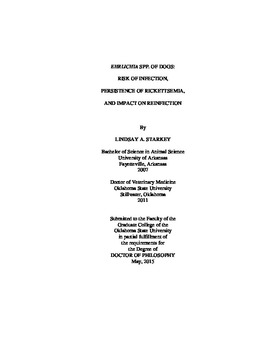| dc.contributor.advisor | Little, Susan E. | |
| dc.contributor.author | Starkey, Lindsay A. | |
| dc.date.accessioned | 2016-04-15T21:49:40Z | |
| dc.date.available | 2016-04-15T21:49:40Z | |
| dc.date.issued | 2015-05 | |
| dc.identifier.uri | https://hdl.handle.net/11244/33457 | |
| dc.description.abstract | The research presented in this dissertation was conducted to further understanding of Ehrlichia spp. infections in dogs in the U.S. and Haiti. In chapter 3, to determine the risk of infection posed to dogs exposed to ticks in a natural setting, dogs were walked through tick habitat in northcentral Oklahoma and monitored clinically, serologically, and molecularly for four months for evidence of tick-borne infection. All 10 dogs were shown by serologic and molecular methods to be infected with E. ewingii, and 7 were co-infected with E. chaffeensis; however, no dog exhibited clinical signs of ehrlichiosis. Four of these Ehrlichia spp. infected dogs were monitored for two years (Chapter 4) following tick-exposure to evaluate long-term Ehrlichia spp. infection. In this study, three of four dogs were infected with E. ewingii for at least 460 days while infection with E. chaffeensis was only detectable through day 55. These data demonstrate that dogs may serve as a reservoir host for maintaining E. ewingii. The third study (Chapter 5) was a pilot trial designed to evaluate the impact that previous infection with an Ehrlichia spp. has on reinfection through tick feeding and intravenous sub-inoculation. The Ehrlichia spp. infected dogs from Chapter 4 were exposed to ticks by walks and monitored for four months for evidence of reinfection with an Ehrlichia spp. as previously described in Chapter 3. No reinfections by tick feeding were detected; however, three dogs sub-inoculated with E. ewingii and monitored for 46 additional days demonstrated molecular evidence of reinfection with E. ewingii. Lastly, Chapter 6 determined the prevalence of Ehrlichia spp. infections in 210 dogs from Haiti. Ticks infesting dogs were collected for identification and blood samples were evaluated by serologic and molecular methods for evidence of Ehrlichia spp. infections. Rhipicephalus sanguineus was the only tick collected from dogs. Ehrlichia canis was the only Ehrlichia spp. identified in these dogs; antibodies were present in 69 dogs and DNA was detected in 15 of those dogs. In summary, the risk of infection with an Ehrlichia spp. is high and infections may persist for years and alter future Ehrlichia spp. infections. | |
| dc.format | application/pdf | |
| dc.language | en_US | |
| dc.rights | Copyright is held by the author who has granted the Oklahoma State University Library the non-exclusive right to share this material in its institutional repository. Contact Digital Library Services at lib-dls@okstate.edu or 405-744-9161 for the permission policy on the use, reproduction or distribution of this material. | |
| dc.title | Ehrlichia spp. of dogs: Risk of infection, persistence of rickettsemia, and impact on reinfection | |
| dc.contributor.committeeMember | Reichard, Mason V. | |
| dc.contributor.committeeMember | Johnson, Eileen M. | |
| dc.contributor.committeeMember | Shaw, Edward I. | |
| osu.filename | Starkey_okstate_0664D_13940.pdf | |
| osu.accesstype | Open Access | |
| dc.type.genre | Dissertation | |
| dc.type.material | Text | |
| thesis.degree.discipline | Veterinary Biomedical Sciences | |
| thesis.degree.grantor | Oklahoma State University | |
